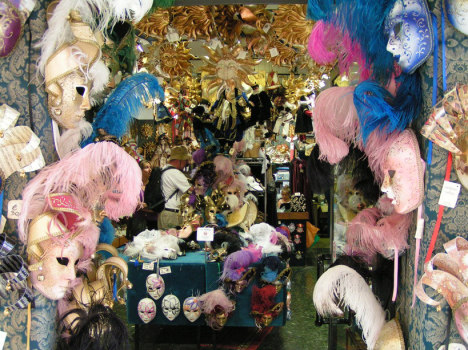Italian Venetian Masks and Their Meanings

Whether you are planning a visit to Venice during the carnival season or are an avid collector wanting to know the history behind your masks, knowing the different types of Venetian masks and their meanings can be beneficial. Ready on to find valuable and intriguing information about the traditional masks that are a crucial part of the history of Venice.

Italian Venetian Masks / Photo by Julius
Venetian masks are often classified under two different categories. The Commedia Dell’Arte Masks represent theater and represent characters, professions, and trades. Listed below are a few of the Commedia Dell’ Arte Mask and their meaning.
- Arlecchino. This mask is characterized by a large red blemish on the forehead and is often used in plays to represent a servant character. An attire of rags would accompany the large red blemish mask.
- Brighella. In comedy theater, Brighella is Arlecchino’s partner. Alongside the Arlecchino mask is the Brighella or money grubbing villain. The green color of the half-faced masked was made to represent greed.
- Burrattino. Also known as Pinocchio, was only mildly popular on stage. The mask was characterized why a long, pointy nose and was a quick witted character.
These were just a few of the many masks that were used in the comedy plays. The Venetian carnival masks have a different style, meaning, and character. Below are the Venetian carnival masks that are still used to help celebrate the carnival season today.
- Bauta. This is the main type of mask worn during the carnival season. This was the disguise or mask often chosen by kings or princes to be worn freely into the city without being noticed. It is worn with a black tricorno, zendale, and a long cape. More traditional versions of the mask are full faced while the more modern versions hit right above the mouth.
- Dama. The Dama mask is perhaps the most beautiful mask at the carnival today. Other names for the mask include Liberty, Olga, Valeri, Salome, Fantasia, and Regina. The simple, elegant mask helps add beauty to the carnival season.
- Gatto. The Italian word for cat is “gatto.” Molded into the shape of a cat, this mask was popular because of the lack of cats in the region at the time. Though not as popular today, the occasional Gatto mask can still be seen during the carnival season.
- Jester. This mask is used to represent a jolly spirit and is characterized by the three points at the end with bells attatched.
- Moretta. Morretta masks are oval shaped and are designed to bring out the natural features of a woman’s face. They are often made out of black velvet and are easier for women to wear. This mask is usually paired with a veil to add to the beauty and elegance. Traditionally, this mask was very difficult for a woman to wear as she has to use her teeth to hold the mask in place. Modern versions of this mask allow her to wear if freely with very little effort.
- Medico Della Peste. If a scary look is what you like, then you are sure to like this mask. It is often referred to as the “plague doctor.” It is a full faced mask that is embellished with a long beak. They now boast bright colors that add interest and even more character to each mask. It often represents darkness and can be extremely intimidating.
- Columbina Mask. This mask is known to disguise the eyes only. It can hide the face using a long rod or fits easily onto the head with an elastic band. Many of them are decorated with jewels, feathers, bright colors, and other highly decorative touches.

Italian Venetian Masks / Photo by Julius
There are many different types of Venetian mask. There is a detailed list of Venetian masks that were used specially for entertainment purposes and that are completely different from the traditional carnival masks that the country of Venice is known for. Perhaps the more interesting and beautiful masks are those that are widely seen during carnival season today. From the scary Medico Della Peste to the beautiful Dama mask, the options are endless for carnival goers who want to experience a taste of history or enjoy the carnival season. If you want to buy some of the masks, you can choose from many here:
http://www.1001venetianmasks.com/



can you plz tel me that why Venetian carnival celebrated ? and why they wear mask? plz tel me
Good question! Carnival was first celebrated in 1162 to celebrate a victory over the Patriarch of Aquileia. But then it was celebrated mainly because the Lent was coming (as the carnival is always celebrated before Lent) and the people were limited with meat, sugar, and fats during the 40 days long Lent. So the carnival was the last time for them to eat and drink everything they wanted. And why the people wear masks during the carnival? Well, I think it’s just because of the tradition. Venetian people used to wear masks for much of the year in the past. Masks allowed them to escape their identity, to have more of anonymity and to act as a foreigner, and thus avoid being judged by others.
Pingback: Why You Can't Miss Venice in February | Espresso by Select Italy